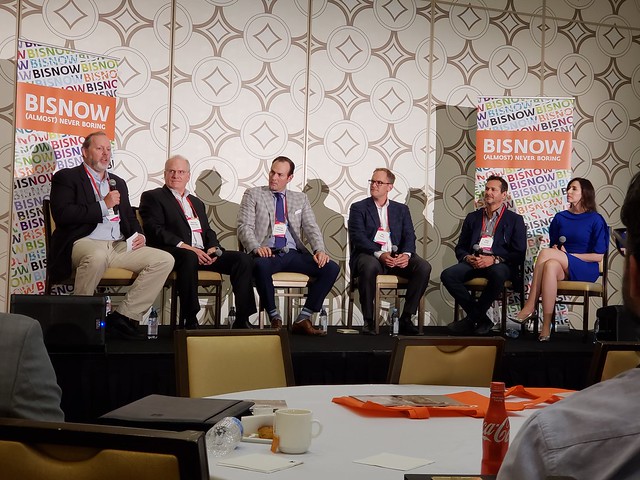What Developers And Investors Say Is The Key To Making Retail Great Again
When architect Kevin Kelley begins work on a retail project, the first thing he asks his team is, “What is the bonfire that is going to bring everyone together?”
“Every job needs a bonfire to bring people into it,” said Kelley, a founding principal at Shook Kelley, during Bisnow’s Retail West conference Wednesday. “You need a great payoff. That payoff doesn’t necessarily mean great prices or great products. It’s really great social payoff.”

In the ever-changing world of retail, developers, investors and brokers are still trying to figure out the secret formula that will bring people into their retail projects, keep them there and drive up sales.
With the behemoth of e-commerce continuing to rise because of its ease and convenience, brick-and-mortar retail stores are struggling to bring in traffic.
“It’s clicks versus bricks,” CoStar Group Senior Market Analyst Steve Basham said.
While retail is far from dead — vacancy in Los Angeles County is a healthy 4%, according to JLL — online sales continue to trend upward and that trend worries many people in the retail industry.
Just this past Labor Day, nationwide consumers went online and spent $2.08B on goods, a 23% increase from $1.69B the previous year, according to the LA Times.
So what will get people out of their homes to shop?
Kelley, along with other developers and investors, said creating social payoffs, unique shopping districts and making it easier for tenants to set up shop are keys to making retail great again.
“As much as we are on the internet, we have a deficit for social engagement,” Kelley said. “All the dot-commers and obsessed Instagrammers are looking for places to go to actually relax, to [wind down] and they are trying to figure out what is the recreational focus or social engagement or the social payoff for going to certain places.”

More than 200 people attended Wednesday's event at the JW Marriott in downtown Los Angeles.
At the conference, panelists discussed the state of the retail industry, the Los Angeles downtown retail landscape, the future of malls and whether retailers should start preparing for autonomous cars.
“It won’t happen in my lifetime,” Donahue Schriber Realty Group Chairman and CEO Pat Donahue said of autonomous cars.
Donahue, whose company has more than 65 shopping centers totaling about 11.5M SF on the West Coast, said the company has no plans to convert any parking garages or excess parking lot space to prepare for self-driving cars.
But the biggest topic that was discussed during the daylong conference was how to get people out of their homes to shop at brick-and-mortar retail stores.
Colliers International Executive Vice President Julie Taylor said mixed-use developments have become very popular — whether office buildings with a retail component or a residential project with ground-floor retail — but she urges developers to work with tenants as they are building the development.
There are things to be avoided or risk those spaces going vacant, she said. In San Francisco, she has noticed some completed mixed-use developments with empty retail on the ground floor.

“Oftentimes the leasing team [is] not brought in [from] the beginning and does not regard what tenants in the market are seeking,” Taylor said, adding that at times the retail space in these mixed-use properties is too large or, if it is a restaurant, may not have the required features to pass health inspection.
“So often these buildings are designed and they look like office buildings and sterile on the bottom floor,” she said. “The creative tenant — a budding chef or entrepreneur, who landlords like in their project — don’t want anything to do with the physical environment because it just isn’t appealing from where they sit. They want to be interesting and they’re looking for more provocative environments. You have to really shake up the ground floor and do something interesting with it.”
GPI Cos. partner Lee Wagman, whose company co-developed Sycamore Hills Plaza and The Upland 365 with LStar Communities in the Upland-Claremont submarket, said the firm was successful by partnering with the retail tenants of the development prior to the 80K SF shopping center being built. The center is 100% leased, Wagman said.
“Retail is still valuable,” Wagman said. “If you have a location that has the right demographics and ... you can bring in retail partners, it can be successful.”
While Kelley, the architect, looks to create social and recreational areas to bring in traffic, Donahue of Donahue Schriber has a simpler approach.
Donahue said none of his complexes have bowling alleys or other forms of entertainment aside from a movie theater. It is hard to make a Ralphs grocery store or a CVS pharmacy entertaining, he said.
“Food and beverage and cinema,” Donahue said, adding that the firm recently added fitness centers to some of its shopping centers. “These have been a very good extension of our hours of operations. It’s been good for us.
“For those of you who haven’t been doing this for 40 years, there is no silver bullet,” he said. “Every piece of property has its own personality and own opportunities. It is your job and my job to find out what that is. … All of this stuff has to work together. You put the right pieces in the right places and hopefully you come away with something that is of value to the customer. It’s all about giving the customer value."
Check out a slideshow of the event here:

